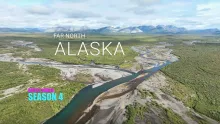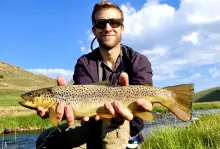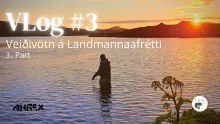On horseback into the pristine areas of Yeallowstone in pursuit for cutthroats. Read Hamilton Brocious' fantastic story from a wilderness fishing camp with ready access to wild native cutthroat trout. So isolated that you won't see any other fishing groups during your whole stay.
Details of a trip that everyone should make at least once in their lifetime
My favorite (fishing venue) was near the Yellowstone in an area known as Castle Creek. The stream was larger, there seemed to be more side streams and the scenery, if possible, was even more spectacular.
- Ham Brocious

Cutthroat in the Yellowstone River like this 20-incher are quite common.
It had to be close to every fly fisherman's dream. A wilderness fishing camp with ready access to wild native cutthroat trout, and so isolated that you won't see any other fishing groups during your whole stay. This article is about a six day trip into one of the most remote parts of the Teton Wilderness just outside of Yellowstone Park.
I first learned about the famous early summer native cutthroat fishing on the upper Yellowstone while skiing Jackson Hole in late March, 1995. We had breakfast with long time Jackson guide and outfitter, Paul Gilroy, who told us about an unusual six week cutthroat trout fishing season in Northwestern Wyoming. This short window usually opens around June 20 and closes by the first week of August 1, and is for cutthroats returning to the headwaters of the Yellowstone River, and adjacent rivers, to spawn.
About Yellowstone cutthroat
These are 14-18 inch trout probably making the only spawning run in their life. The males are 3 to 4 year fish while the females are usually either 4 or 5 year olds. For those of technical bent this strain of cutthroat is known as Salmo Clarki Bouveri or Yellowstone cutthroat. The Bouveri is the largest (in total numbers, not size) of the 14 different species of cutthroat trout identified by Patrick Trotter in his remarkable book entitled "Cutthroat": Native Trout of The West. I recommend this book highly to anyone who wants to learn virtually everything about cutthroats. (Colorado Associated University Press, Boulder, Colorado, 80309). Mr. Trotter points out that the Yellowstone cutthroat probably owes its large population to the fact that its principal range is largely in a national park, protected from the ravages of advancing civilization. Another variety, the Fine Spotted cutthroat, is found mostly in the Snake and Gros Verntre, and Buffalo rivers. When good water conditions prevail catches of 20 fish or more per day during this six week period are customary, and fishermen frequently report more than twice that amount. That's the good news. The other side of the story is that it takes a long 8 hours on horseback to get to one of the few fishing camps in the Teton Wilderness that specialize in these early summer cutts...and that's a long ride.

Ray Bowers sits on edge after 5 days of horseback riding.
According to Paul, fly fishing in the Jackson area offers some fine brown and cutthroat action on the Snake, Buffalo, Hoback, Gros Ventre and many other streams and lakes. This fishing has the advantage of much easier access and is the usual choice of most visiting anglers. But for me the hook was set and I was already mentally
on the horse headed for the high country. Plane schedules are conveniently arranged to get you to Jackson Hole by mid-day which allows plenty of time to make the traditional visit to the fly fisherman's mecca, Jack Dennis Outdoor Shop. Although I could write an entire article on this famous shop I'll resist and just say that it's my favorite store anywhere. At Jack Dennis you can pick up your Wyoming license ($25 for five days) and fill in the holes in your fly boxes with some of the local favorites and don't forget to ask for the currently in-vogue insect repellant.
On our way
The scheduled 6:30 am pickup at the Antlers Motel by Yellowstone Outfitters owner Lynn Madsen was on time and we were on our way to the base camp 35 miles north in Turpin Meadows near Moran. Our group included my son-in-law, Paul Vaivoda, who is an architect from Skaneateles, NY and a newly met fisherman friend, Rich Ievoli, a psychologist from Carlisie, PA. At the base camp we were outfitted with horses and saddles, had our
gear packed on mules for the trip and by 9:00 we were on our way, 3 fishermen, 2 wrangler guides and a six-mule pack train.
Steady climbing led us up from the Buffalo River valley to Two Oceans Pass, so named because it straddles the Continental Divide. (You all remember that one side of the divide flows towards the Atlantic coast and the other side goes to the Pacific side.)
SIDETRACKED BY THE FIRE OF '88
The Yellowstone fire of 1988 has transformed the stately lodge pole pines into ghostly white sentinels that dominated the forests once we got to the high country. Of the over 2,500,000 acres of the Park, nearly 800,000
acres were destroyed in this huge fire with several hundred thousand more laid waste south of Park. Natural reforestation of this burn area has been slow and seven years later there is only 12 to 18 inch brush grown up in most areas.
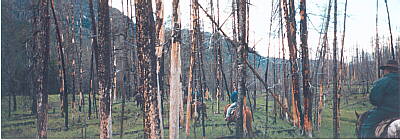
The fire damage was evident for most of the 27 mile ride in.
The remaining standing dead trees present a constant hazard since, without any roots, they are constantly falling down with a resounding crack whenever the wind picks up. Eight hours later, after exciting stream fordings, spectacular scenery and many deer and elk sightings, we arrived at the fishing camp in Yellowstone Meadows.
At the camp
Without belaboring the point, eight hours is a helluva long time in the saddle for anyone, and especially for eastern tenderfoots! But the good side of such a long ride is the almost total absence of any other fishermen during our entire stay, which was to be four days of fishing. Horses are the only way in because there just aren't any roads at all and helicopters are banned by the Forest Service, except in emergencies. Our camp, at an elevation of 7,700 feet, was located 4 miles south of the Yellowstone Park boundary, 15 miles north of the headwaters of the Yellowstone River and 2 miles west of Hawks Rest Mountain. Temperature in this first week of July ranged from a frigid 28 F. in the morning to low 60's in the mid afternoon. Water temperature was around 58 degrees.
The camp consisted of two 25 x 25 fly tents, a two man tent for each person, an outdoor shower, latrine tent and a tethering and saddling area for horses...and that was it. The one fly tent served as the cook shack, housing all the food and cooking supplies. A series of heavy aluminum chests with heavy clasp latches were required for protecting the stored food from foraging animals including the occasional black bear. The other tent was the eating and social area, with a perpetual fire in the center and a circle of logs for seating.
There was also a supply of folding chairs for sitting around the fire when the logs got too hard, and always a large pot of piping hot coffee. An important utilitarian feature was the drying line above the fire which seemed to always be in use.
The two man tents were pyramid style with built in floor and were plenty large for sleeping bag, air mattress and duffle bags. The tents were pitched in a large open meadow so that they were not in danger of being struck by any of the falling burned out timber. The wisdom of this was appreciated early one evening when a 60 mile an hour wind and rain squall roared down from Yellowstone Park and left dozens of trees snapped off in its
wake.
The daily routine didn't vary much with the only changes being the different locales chosen for each day's fishing. Early risers could get in some chilly fishing at several large pools of the Yellowstone about 300 yards from the camp before breakfast which was served around 7:30. Paul and Rich each caught some nice 16 inchers on several mornings, mostly on retrieved streamers (and, horrors...an occasional Mepps spinner!).

One of the pools on the Yellowstone River was only 100 yards from camp.
Our camp cook, Carla Turner, was up at the crack of dawn and had the ever present coffee pot on the fire by 6. Breakfast can be best described as a "lumberjack's dream!". You name it and Carla made it. Bacon, sausage, ham, eggs, home fries, French toast, regular toast, baking powder biscuits, fruit, cereal, juices and coffee by the gallons. While we were getting our gear ready after breakfast and making our lunch in the cook tent, the wranglers saddled the horses and packed our waders, rods and tackle, fishing vests, and cameras on mules for each days trip. With a total of eight fishermen in camp we usually divided into 2 four man parties plus a wrangler guide and one mule. We got under way each day at around 8:30 for a ride of around 1 1/2 hours to our chosen site for that day.
On our first day we fished the Atlantic River in a mountain meadow near Two Ocean Pass. Earlier in this article I indicated that water conditions had an effect on the size of catches. So, here a little about the condition of the streams during our trip is in order.
The Spring of 1995 produced one of the largest and latest snow packs in the western mountains in more than a decade. That made for great skiing while we were in Jackson in March, but the late snow runoff left the streams unusually high. So high, in fact, that one of the choice streams, the Thorofare, was inaccessable because the horses could not ford the river.
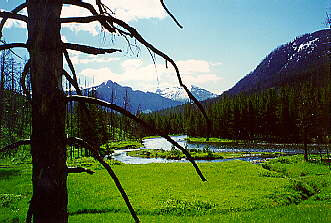
The Thorofare River provided fantastic small river cutthroat fishing.
Fishing techniques
The main body of both the Atlantic and Yellowstone rivers were also relatively high, necessitating fishing in their seemingly endless side streams and branches which were clear and easily fishable. And right from the start we saw and caught lots of cutthroats, generally on size 8 and 10 muddlers, black and olive wooly buggers, stimulators, and egg patterns. I started out with a 7x leaders hut after a 2 pound cuttthroat in swift deep water left me staring at a broken tippet I quickly followed the guide's suggestion to stay with 4x or 5x. In some gravel rimes we could see as many as 20 trout holding in the current, sometimes with a spawning female rolling over depositing her eggs while waiting males did their job in the age old process. Large open spaces of water with few streamside trees and high brush made for excellent fly casting conditions, but the high roily water from the late runoff had delayed the appearance of usual hatches and wet flies were the order for the whole time we were there. "You should have been here last year ...at this time it was all dry flies", said head wrangler and camp manager, Griz Turner,. (Seems like the story of my life...it always was great last week, last month, last year!) At four o'clock we rode back to camp, thoroughly pleased with our first day. My catch for this day was 11, all between 14 and 16 inches. I probably could have caught some more but I spent a lot of time just drinking in the splendor of the Wyoming mountains and watching my companions in action. We had been advised to put a fish in our saddle bag if we wanted trout for dinner, but tonight's steak menu seemed too good to pass up.
And there's always tomorrow.

Ray Bowers hooks into another cutthroat on a tributary of the Thorofare River.
Back at camp by 5:15, what did we do? Tossed our gear in the tent and headed for the afternoon pool where I caught my largest cutthroat of the trip, a fat 17" beauty with deep coloring and a bright red slash at the gill. He hit right at the end of the retrieve, about 15 feet from the bank and actually jumped right towards me. (I say "actually" because Yellowstone cutthroats are not noted for being jumpers.) After a dinner of all the steak you could eat and the trimmings, came my favorite time in camp (after fishing, of course). Sitting around the fire, getting to know the other fishermen, swapping stories about the days activities, and listening to the wranglers' lore of the mountains.
Included in our group was Irvin Browner, from Lennox, Massachusetts, on his 25th visit to the Yellowstone Meadows. Irwin, now 78, first came here in 1970, and now, by his own definition, "catches just enough cutts to keep me happy", and still marvels at the grandeur of these mountain meadows. Rich Ievoli, our
partner on the ride into camp, and Steve Schweitzer, from Chicago, used the time before dinners to set up their fly tying gear in the mess tent to replenish their fly boxes. Steve, who must rank high on any list of most enthusiastic fly tying devotees, designed a special fly for the Yellowstone cutthroats, and called it the "Griz Bugger", dedicated to camp manager, Griz Turner. Great thing about Steve was his generosity, since he tied enough "Griz Buggers" to give one to each of us. The fly, which was a combination of a type of olive wooly bugger and an egg-sucking leech, lured a half a dozen or more fish to my net.
The Invincible GrizBugger
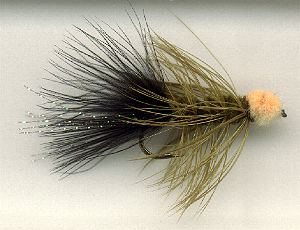
The GrizBugger is nothing more than an extremely fluffy woolly-bugger and isn't overly inventive. But, for some reason, the cutthroat of the Yellowstone had a special taste for the combination of black, olive and orange. I tried other combinations, including reversing the black and the olive, but nothing seemed to work as effectively. (And I had the consensus of 4 other anglers...so I am not as crazee as this sounds!) Certainly, if you didn't include the orange egg head, the fly wouldn't produce. I tied the fly with a few strands of krystal flash in the tail and used dark olive chenille for the body. Tie the egg yarn at the head first, it's much easier that way. Either wrap it on or spin it, it doesn't really matter. Sizes 4 - 8 were equally effective. This fly will be in my arsenal for any cutthroat fishing I do in the future.
- Steve Schweitzer
The next three days were much the same in activity, but each totally different because of the fishing venues. My favorite was the near the Yellowstone in an area known as Castle Creek. The stream was larger, there seemed to be more side streams and the scenery, if possible, was even more spectacular. I averaged 10 to 12 fish each day and on Thursday did slip one into my saddlebag for dinner that night. (With fish of this size, one was perfect for dinner) The initial thrill of the first day never waned. Particularly memorable was to see an osprey pick up a cutthroat out of the water and fly off to the timber. It added to an almost mystical feeling I had about being in a totally uncivilized mountain wilderness that's just as it was thousands of years ago. We were under the constant observation of game animals. Several mornings I heard a snorting , looked out and saw a pair of moose, about 10 feet from my tent. We saw hundreds of elk, mule deer, many other moose, coyotes, a black bear, beaver and numerous eagles. And porcupines were a big pest because of their desire to gnaw on saddle leather and reins. After finding some thoroughtly chewed leather for a couple of mornings, Grit put
an end to the havoc with a couple of well placed shots late one night.

Plenty of guests were around for mealtime... including the young moose who found the campsite grazing the best around.
Not necessarily for the faint of heart - and the gear you will need
Now, a few comments about fishing camps and remember, I'm talking about mountain wilderness camps where you live in a tent. First off, and foremost, they're WET! Walking through knee high brush in the morning dew means wet boots and pants, and mud!. Plus rain (it does rain, even in paradise!),...it all adds up to the camp fisherman's #1 friend...a good pair of waterproof shoe pacs, upper calf height (about 14") If you're wearing Levi's,and you should, bring three pairs. Add to that twice as many thick socks as you think you'll need and a good woolen sweater. I found that I lived in my LL Bean chamois cloth shirts. You'll need rain gear. (a poncho is good to keep dry on horseback).
Bring a good heavy coat or jacket and forget the bathing suit (even if the brochure tells you to bring it.). The water is below 60 degrees and you don't even want to think about swimming. Remember, it gets cold in the mountains, even in the summer. Long underwear is recommended, especially since it helps cut down the chafing when you're on long trail rides and it feels pretty good at night when you crawl into that cold sleeping bag. I'm not going to dwell on the obvious things such as sleeping bags, mattresses, flashlights, etc. You'll get all those recommendations when you read the brochures. My main suggestion is to assume that it will be wet and figure how to best cope. Fishing gear recommendation...a wading staff. These are swift streams with undercut banks and you need all the help you can get. You should be able to fit one in a rod case.
One afternoon Rich lost his footing wading the Yellowstone and went in up to his neck in the frigid water. Do bring chest high waders. You may hear that you can get along with hip boots, but don't believe it. And, don't worry about bringing too much gear. They'll pack it all on a mule and he really doesn't care if there's an extra few pounds. Two rods and a couple of reels are enough. You'll have the opportunity to make some long casts so I would bring one 9 foot 6 weight and one 8 foot 4-5 weight.. And don't forget, there isn't any tackle shop nearby so you better bring it with you. Ask the guys at Jack Dennis for some recommendations, and then, believe them. Leave your creel home. Put a small pair of needle nose pliers in your vest to crimp down the barbs on your flies. A Leatherman multi tool works just fine and is useful many times a day. If I didn't mention it, this is all catch and release fishing. (No ice to keep them even if you wanted to, and it feels great to get them back in water in perfect shape). Don't bother with a portable radio (no stations to receive), but a discman with some of your favorite CD's is a great way drop off to sleep at nights. Pack some extra batteries. Mine gave out after two nights and my private concerts were over. A cold beer or two after fishing tastes just about as good as beer can ever taste. So if this sounds good to you, by all means bring along a couple of six packs. Our camp was by an open spring and that was the cooler for everyone's drink stash. It's easy to bring a couple of six packs with you and you'll find the mules, as always, will be tolerant of the extra weight.

Pack mules carrying gear, food and camp supplies to the guests and resident outfitters.
And that's about it. After 5 days in the saddle the trip back on the sixth day didn't seem nearly as long and we arrived back in Jackson late in the afternoon in time for a long shower and another visit to Jack Dennis before a good dinner. To sum up in a few words...wonderful fishing in a spectacular environment, truly a Yellowstone Adventure.
To contact Yellowstone Outfitters, call 1-800 447 4711 for their colorful brochure.
The trip described in this article includes everything from the pick up in Jackson to delivery back 6 days later.
You can reach Paul Gilroy in Jackson, Wyoming at 307-733 4314
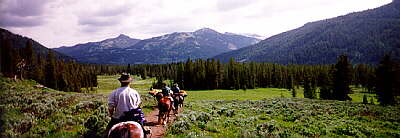
Heading Home.
- Log in to post comments




